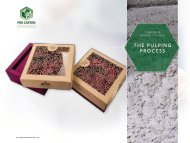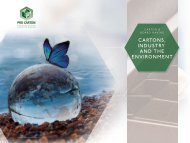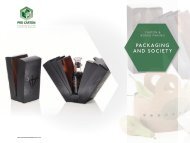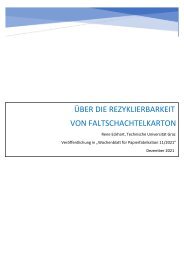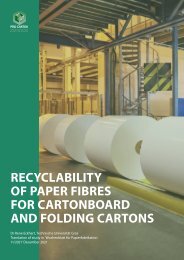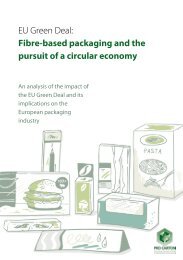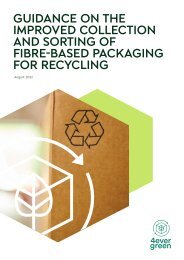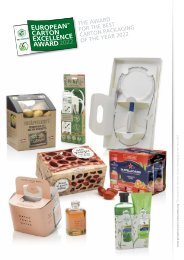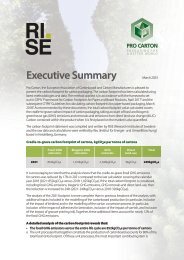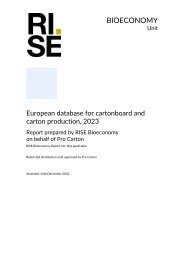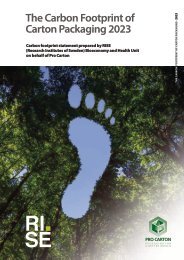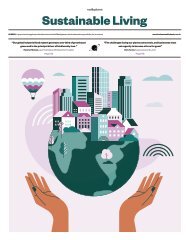European Database for Cartonboard and Carton Production 2023
You also want an ePaper? Increase the reach of your titles
YUMPU automatically turns print PDFs into web optimized ePapers that Google loves.
41<br />
Method of disposal or<br />
recovery<br />
99%<br />
incinerated<br />
with energy<br />
recovery, 1%<br />
recycled<br />
100%<br />
incinerated<br />
with energy<br />
recovery<br />
Rejects, other*** kg/t 44.91 1.14 - 26.40<br />
Dry content % 45% 50% - 48%<br />
99%<br />
100%<br />
Method of disposal or<br />
-<br />
incinerated incinerated<br />
recovery<br />
with energy with energy<br />
recovery, 1%<br />
recycled<br />
recovery<br />
Aqueous liquid waste kg/t - - 0.59 0.59<br />
containing ink<br />
Dry content % - - n/a<br />
Method of disposal or<br />
Not specified<br />
recovery<br />
Aqueous sludges<br />
kg/t - - 3.02 3.02<br />
containing ink<br />
Dry content % - - n/a<br />
Method of disposal or<br />
Not specified<br />
recovery<br />
Paper <strong>for</strong> recycling kg/t - - 169 169<br />
Dry content % - - 90% 90%<br />
100%<br />
100%<br />
Method of disposal or<br />
-<br />
recycling recycling<br />
recovery<br />
Paper packaging waste kg/t - - 2.06 2.06<br />
Dry content % - - n/a<br />
100%<br />
Method of disposal or<br />
- -<br />
recycling<br />
recovery<br />
Plastic packaging waste kg/t - - 3.29 3.29<br />
Dry content % - - n/a<br />
100%<br />
Method of disposal or<br />
- -<br />
recycling<br />
recovery<br />
«na» not available<br />
*As this life cycle inventory is intended to be representative of average <strong>European</strong> production, only transport<br />
from <strong>European</strong> paper mills to <strong>European</strong> carton converting sites has been considered in the weighted average.<br />
Transport associated with export of paper outside of Europe has not been considered<br />
**Rejected materials that were associated with the previous use of the paper (<strong>for</strong> example, staples, paper<br />
clips, tags, adhesive labels, unrecovered fibres, etc)<br />
***Material that is not in any way associated with the previous use of the paper (<strong>for</strong> example, <strong>for</strong>eign items<br />
such as plastic packaging, glass, s<strong>and</strong> <strong>and</strong> grit, etc)<br />
-<br />
Additional in<strong>for</strong>mation on energy <strong>and</strong> fuels<br />
Internal fuels<br />
The energy inputs presented in the life cycle inventories in Table 2 only to external fuels<br />
supplied to the process. However, many papermills also produce their own internal fuels<br />
as a by-product of the pulping processes or from the management of waste streams. In<br />
particular, the following are the main internal fuels relevant to the papermaking process:<br />
• Black liquor – a by-product from chemical pulping processes when<br />
digesting pulpwood into paper pulp. It is an aqueous solution of lignin residues,<br />
hemicellulose, <strong>and</strong> the inorganic chemicals used in the process<br />
© RISE Research Institutes of Sweden



